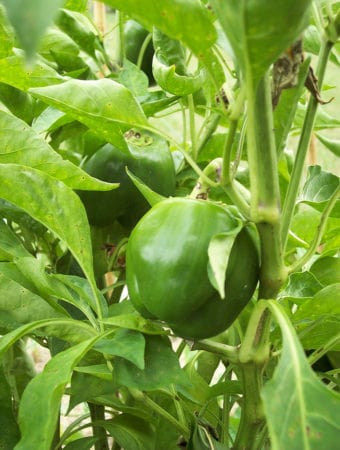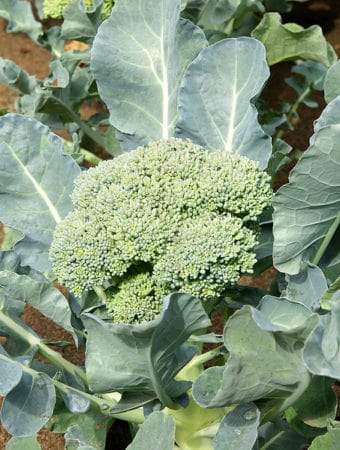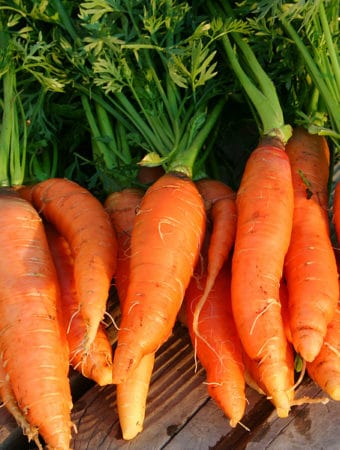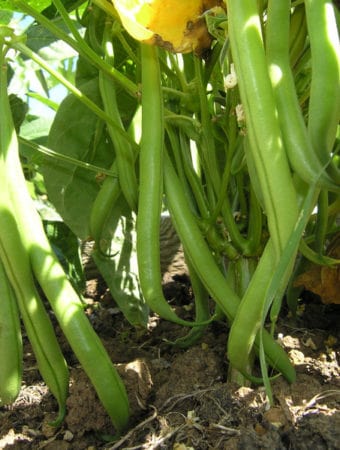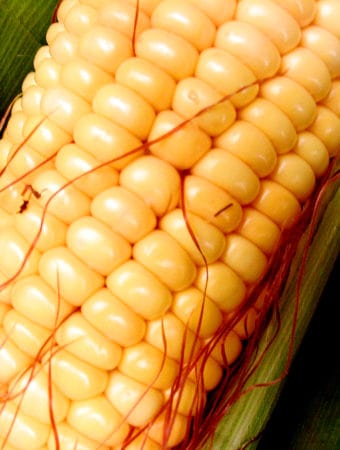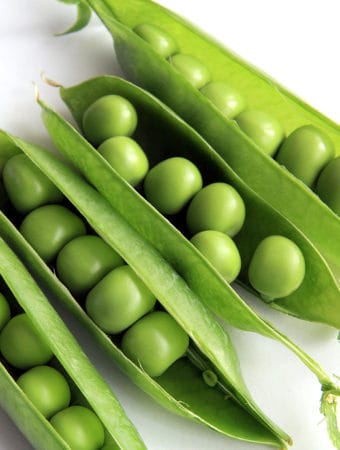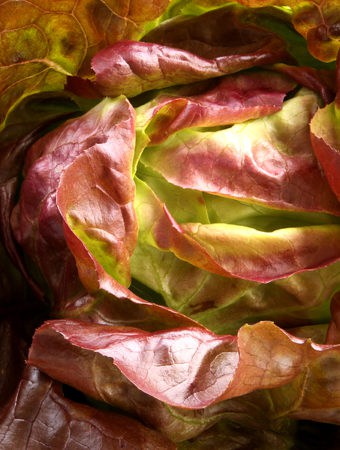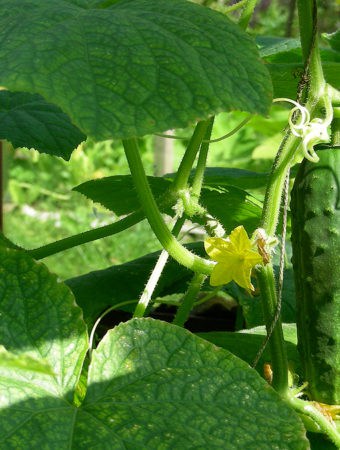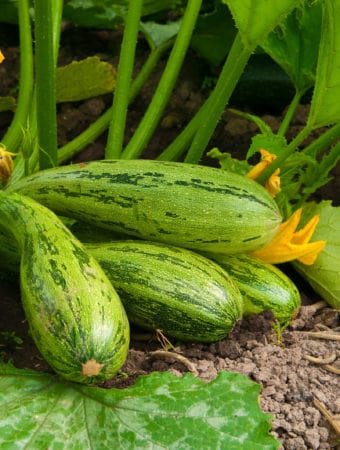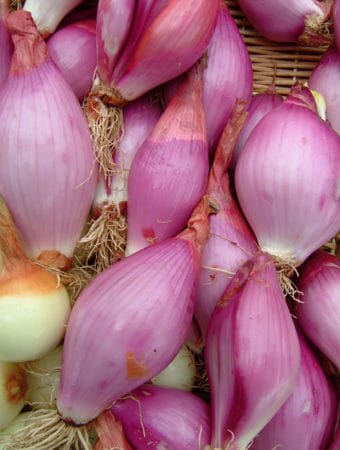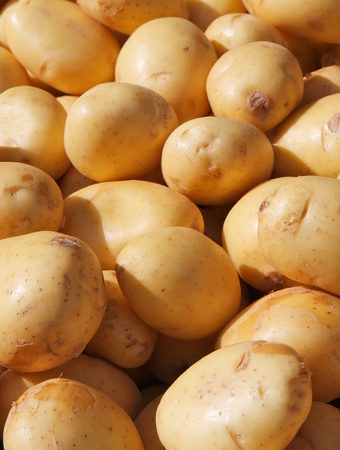Peppers come in a wide variety of shapes, sizes, and flavors. From mild, sweet bell peppers to fiery, spicy chili peppers, there is a pepper to fit everyone’s taste. If you’re looking to add a little something extra to your garden, consider growing some peppers!
Sweet peppers and hot peppers can be grown from seeds or from seedlings. Peppers are most easily grown in the garden from seedlings started at home indoors or from young plants purchased at the garden center.
Starting peppers from seed will allow you to make the widest selection of varieties. It is also the least expensive way to grow peppers.
Related articles:
- Five Ways to Cook and Serve Sweet Peppers
- Five Ways to Cook and Serve Chili Peppers
- Pepper Seed Starting Tips
- Six Tips to Grow Peppers for Flavor
- 7 Tips for Growing Peppers in Pots
- How to Harvest and Store Peppers
- How to Grow Sweet Bell Peppers
- How to Plant and Grow Hot Peppers
- Pepper Growing Problems Troubleshooting
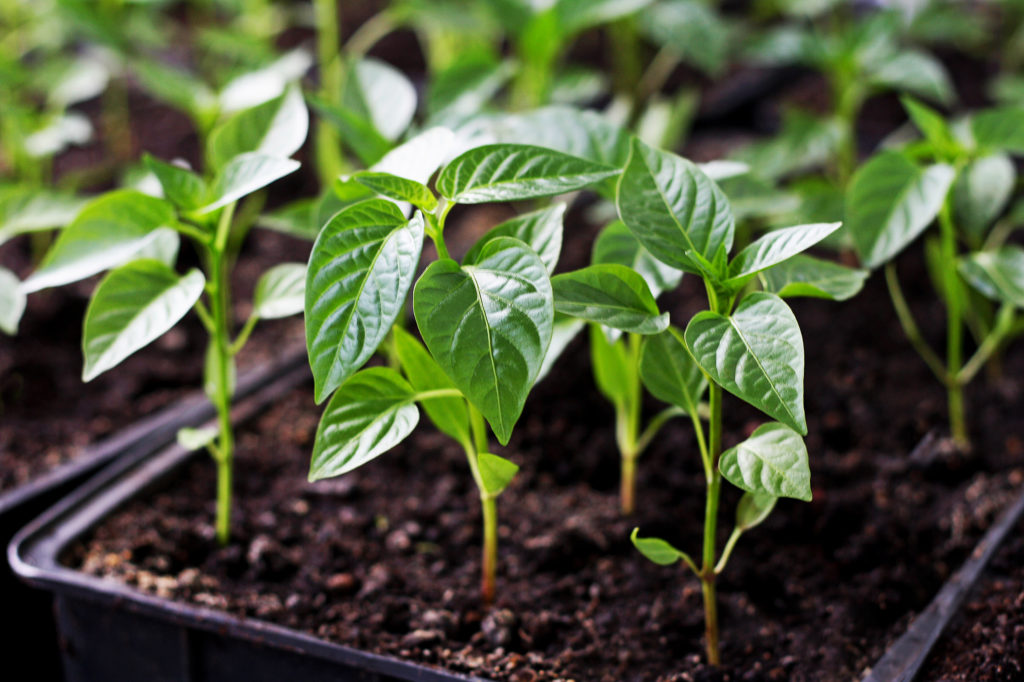
Start pepper seeds indoors about 10 weeks before the date you intend to set peppers into the garden. Don’t rush peppers into the garden. Transplant pepper seedlings into the garden 2 to 3 weeks after the last frost in spring, after the soil temperature has warmed to at least 65°F (18°C).
Peppers mature in 60 to 95 days depending on the variety.
Here is your complete guide to growing both sweet and hot peppers. For a more thorough look at growing chili peppers be sure to read How to Plant, Grow, and Harvest Hot Peppers.
Pepper planting details
Plant peppers where they will succeed. Peppers want full sun and deep, sandy, or gravelly loam–meaning rich and well-drained. Add plenty of aged-compost and organic matter to planting beds in advance of transplanting peppers. A pH of 5.5 to 7.0 is optimal. Raised beds will give peppers the soil warmth they need–and black plastic sheeting or mulch will help warm the soil. Magnesium helps peppers develop fruits; work a dusting of Epsom salts or Dolomitic limestone into the bed just before planting. Side-dress peppers with compost when flowers appear and again three weeks later.
- Sowing depth: ¼ inch (6mm)
- Space between plants: 18-24 inches
- Days to sprout: 10
- Days to harvest: 65-95
- Storage period: 10 weeks
- Seeds per 100-row feet: 1 packet (75 plants)
- Yield per 100-row feet: 50 pounds
Starting pepper seeds indoors
- Start pepper seed indoors 7 to 10 weeks before the date you intend to set seedlings into the garden.
- Sow 3 to 4 seeds in a pot or across flats.
- Sow seed ¼ to ½ inch (7-13 mm) deep.
- Germination soil temperature is 75-95°F (24-35°C); the optimum soil temperature for germinating seed is 85°F (29°C).
- Germination takes 7 to 10 days at 85°F (29°C) or warmer.
- Keep the seed starting mix just moist until seedlings emerge.
- Clip away the weaker seedlings once the strongest seedling is about 2 inches (5 cm) tall.
- Seedlings started indoors should be kept under grow light or in a sunny window after germination. Keep the indoor nighttime temperature above 62°F (17°C).
- Water to keep the seed starting mix from drying.
- Transfer seedlings to a larger container once they are 2 to 4 inches (5-10 cm) tall; be sure that seedlings have sufficient room for root growth. This process is called “potting up.” Continue to pot up seedlings as they outgrow containers—until they are transplanted into the garden or a very large container.
More tips on growing peppers from seed: Pepper Seed Starting Tips.
Purchasing pepper seedlings
- Pepper seedlings in 4-inch pots available at the garden center will be about 8 to 10 weeks old.
- If you grow peppers from purchased seedlings, choose the healthiest, strongest young plants. Look for foliage that is dark green and unblemished.
- Choose plants that are well-branched, dense, and compact. Avoid plants that are tall and leggy.
- Avoid pepper plants with flowers or fruits unless it is mid-to-late season. Plants with flowers and fruits will be slow to establish after transplanting.
Plant transplants with strong stems and dark green leaves. Watch out for leggy or spindly plants; they may not have had enough light getting started. Avoid pepper seedlings with blossoms or fruit. Pepper seedlings need to conserve their strength while they develop roots. The root system of a pepper seedling is not strong enough to support flowers and fruit while it is getting started in life. When you buy starts at the garden center, look for plants with stout stems, dark green leaves, no flowers or fruit, and no blemishes. These plants are the healthiest.
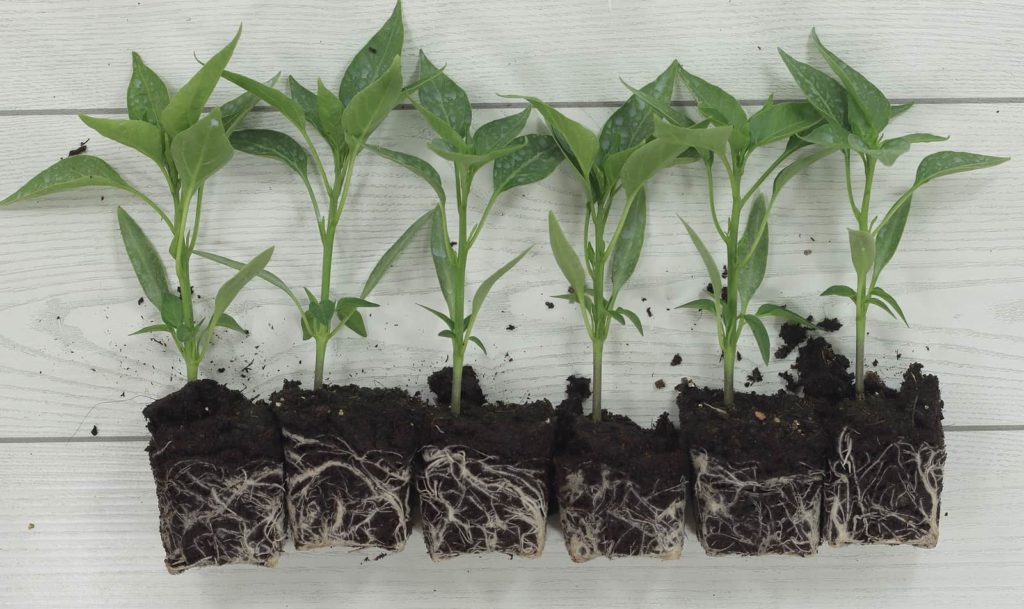
When to plant pepper seedlings outdoors
Don’t rush peppers into the garden; don’t plant peppers at the same time you plant tomatoes. Wait! Nighttime temperatures should be above 60°F and never fall below 55°F. The soil temperature should be 65°F or greater in the morning before you transplant peppers into the garden.
Set plants out when the soil temperature is 60°F to 70°F is better. Do not rush peppers into the garden until the soil is warm. They will not do well if the soil is cool. You can warm the garden bed by covering the ground with black plastic mulch or sheeting for two weeks before transplanting. If the weather is not settled, peppers will benefit from the protection of floating row covers–this will keep the heat in and the bugs out. Keep peppers covered until daytime temperatures average in the mid-80°sF.
Harden off pepper starts before transplanting them into the garden. Put seedlings in a warm, sheltered place outdoors for a few hours each day to harden them off; do this for 10 days before transplanting. Don’t transplant peppers out until overnight temperatures are greater than 60°F; if your peppers are in the garden sooner be sure to cover them with a floating row cover.
Give peppers a good boost at planting time. At the bottom of the planting hole add a handful of compost along with a teaspoon of 5-10-10 (or like percentages) fertilizer mixed with some soil as a buffer between the new roots and fertilizer. Set peppers in a hole about six to eight inches deep and space plants about 15 inches apart–so that the leaves just touch at maturity.
Pepper seedling planting dates
Plant pepper seedlings in the garden 2 to 3 weeks after the last frost in spring. Start pepper seeds indoors 8 to 10 weeks before setting transplants in the garden. Don’t set out pepper seedlings until the average night temperatures are 55°F (13°C).
You can set pepper seedlings in the garden earlier if they are protected from the cold by a plastic tunnel or other season-extending devices.
(These dates are for the Northern Hemisphere)
| Average date of the last frost | Planting dates |
| Jan. 30 | Feb. 1-Apr. 1 |
| Feb. 8 | Feb. 15-Apr. 15 |
| Feb. 18 | Mar. 1-May 1 |
| Feb. 28 | Mar. 15-May 1 |
| Mar. 10 | Apr. 1-June 1 |
| Mar. 20 | Apr. 10-June 1 |
| Mar. 30 | Apr. 15-June 1 |
| Apr. 10 | May 1-June 1 |
| Apr. 20 | May 10-June 1 |
| Apr. 30 | May 15-June 10 |
| May 10 | May 20-June 10 |
| May 20 | May 25-June 15 |
| May 30 | June 1-15 |
| June 10 |
Peppers temperature sensitivity
Peppers drop blossoms when temperatures exceed 90°F. Peppers are particularly sensitive to temperature at flowering time. There will be poor fruit set if nighttime temperatures fall below 55°F or rise above 75°F. Peppers will drop their blossoms if daytime temperatures rise above 90°F. And if the fruit has already set, these same temperatures will delay fruit development. In very warm summer regions, planting peppers where they will be shaded during the day is the best course.
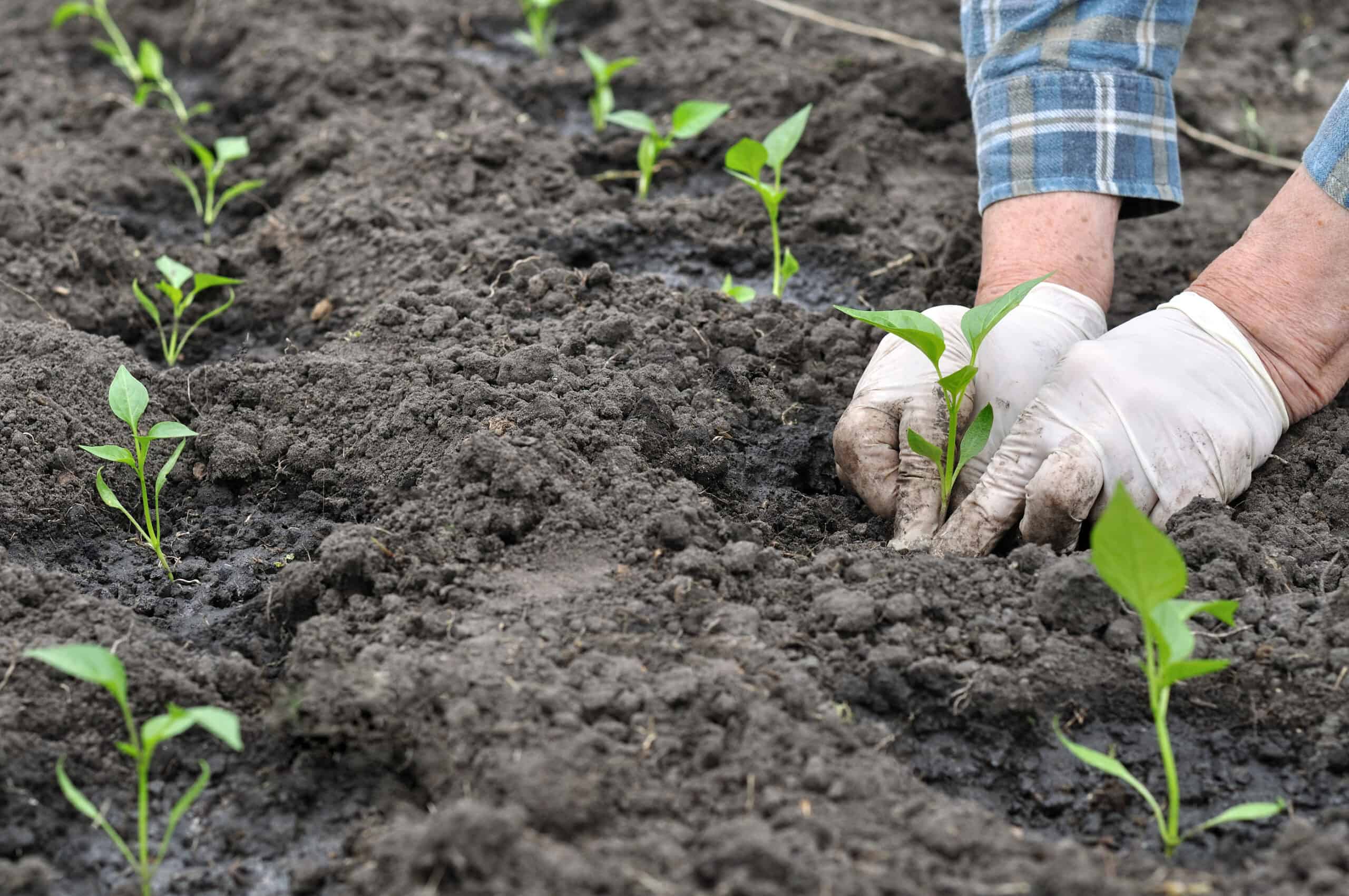
Planting peppers outdoors
Peppers prefer deep, aged-compost–rich soil. If your soil is heavy with clay, grow peppers in a raised bed, adding loam and sand. Peppers grow best in sandy loam that is well-drained and fortified with a lot of organic matter such as aged compost. Plant peppers in full sun. Keep the soil evenly moist from flowering through harvest.
Growing peppers in your native soil: add at least 2 inches of aged compost across the planting bed and sprinkle with 5-10-10 organic fertilizers, then turn the soil to at least 18 inches deep. (Soil that is too rich with nitrogen will produce plants with luscious foliage but few flowers and fruit.)
- Transplant peppers into the garden 2 to 3 weeks after the last frost in spring when the soil temperature has risen to at least 65°F (18°C).
- Young peppers transplanted should be 4 to 6 inches (10-15cm) tall.
- Plants started indoors should be acclimatized to outdoor temperatures before transplants. Set plants outdoors for a few hours each day before transplanting them to the garden.
- Sweet and hot peppers grow best in air temperatures of 65° to 80°F (18-26°C).
- . The ideal temperature for sweet peppers is a daytime temperature of around 75°F (24°C).
- and a nighttime temperature around 62°F (172°C).
- Grow peppers in full sun. Peppers should get 8 hours of sun each day.
- Plant peppers in soil rich in organic matter. Work aged-garden-compost or commercial organic planting mix into beds prior to planting.
- The soil should be moisture-retentive but well-draining. Slightly sandy or loamy soil is best.
- Pre-warm the soil before transplanting by placing black plastic over the planting bed for two weeks prior to transplanting peppers. The plastic will transfer solar heat to the soil.
- Set transplants in the garden at the same depth they were growing in the container. Do not plant deeper; the buried stem may rot.
- Peppers prefer a soil pH of 5.5 to 6.8.
- Avoid planting peppers where another nightshade (Solanaceae) family crop has grown recently—tomatoes, potatoes, and eggplants. These crops can be attacked by the same pests and diseases.
Pepper transplanting tips
Feed peppers at transplant time. Dig a hole about 6 inches deep, add a 2-inch layer of aged compost and a handful of 5-10-10 organic fertilizer—mix this well at the bottom of the hole. Then set the plant in the hole.
Adding rock phosphate to the bottom of the planting hole at transplant time will help prevent blossom end rot.
Set peppers seedlings in the transplant hole slightly deeper than the soil level. If your seedling is in a peat pot be sure to bury the entire pot; peat pot material left above the soil level will act as a wick drawing water from the plants and may kill them. Heal in your transplants.
Spacing pepper plants
Peppers should be closely spaced. The leaves of mature pepper plants should touch each other. Set bell peppers 18 inches apart and hot peppers 12 inches apart.
- Space pepper plants 18 to 24 inches (45-61cm) apart in each direction.
- Space rows 24 to 36 inches (61-91cm) apart.
Pepper companion plants
Plant peppers where they will be shaded by taller plants later in the summer.
Peppers can share space with cabbage and onions. Carrots are a companion that is said to enhance the growth of peppers.
Peppers seem to grow well when planted near cabbage, onions, carrots, basil, parsley, and tomatoes.
Container growing peppers
- Peppers can be grown in pots or containers that are at least 12 inches (30cm) wide and 8 to 14 inches deep. For more about growing peppers in pots and containers read 7 Tips for Growing Peppers in Pots.
- Plant peppers in a commercial potting mix.
- Choose a container with holes in the bottom for easy drainage.
- Keep the soil evenly moist.
- Side-dress plants with compost tea or dilute fish emulsion every two weeks through the growing season.
- In larger containers, set plants on 12-inch (30cm) centers.
Good Products for Growing Your Garden
- 55 Heirloom Vegetable Varieties–27,500 Non GMO Seeds
- Heirloom Vegetable Seed Collection – 105 Varieties
- Full Spectrum, LED Grow Lights
- Seed Starter Kit with Humidity Dome (120 Cells Total Tray)
- Galvanized Raised Garden Bed with Cover
- Gardzen 10-Pack 10 Gallon Grow Bags
- Captain Jack’s Dead Bug Brew
- Harris Neem Oil Plant Disease Control
- Freeze Protection Garden Mesh Netting Kit
- Kitchen Garden Grower’s Guide Vegetable Encyclopedia
- Vegetable Garden Almanac & Planner
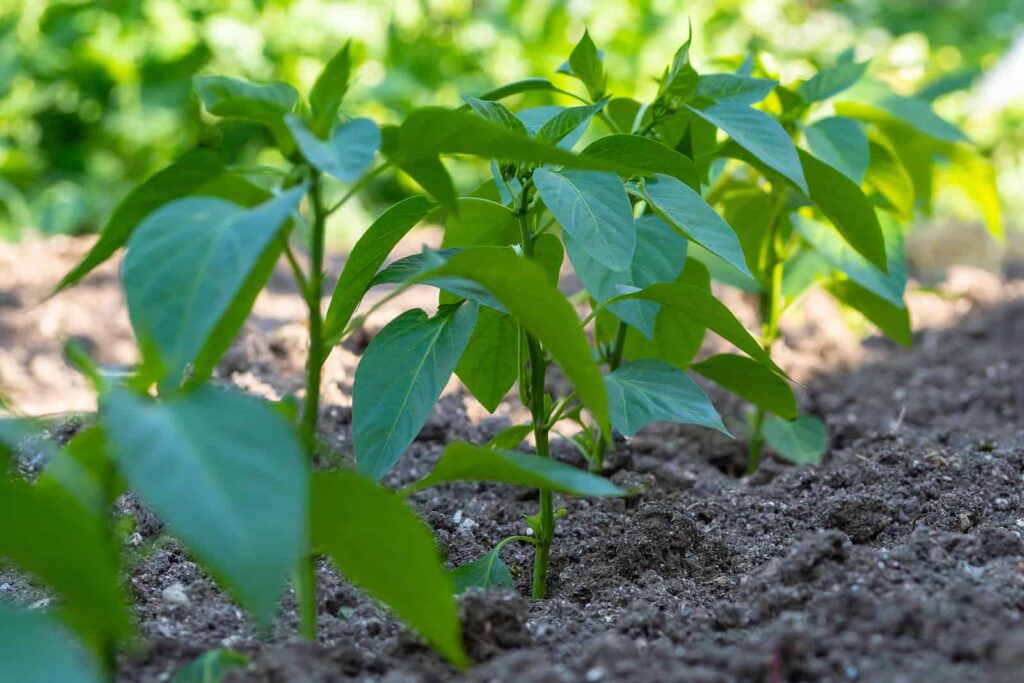
Watering peppers
Water peppers deeply to encourage deep-root development. Too little water can result in bitter-tasting peppers. Peppers want even, moderate moisture around their roots. A gallon of water–about an inch–per plant once or twice a week applied slowly so that the moisture seeps to the roots is best. Avoid overhead watering especially when peppers are in bloom, overhead water will wash away pollen and any chance of fruiting. Be careful not to overwater’ overwatering will cut off the supply of oxygen to pepper roots.
Keep the soil evenly moist, not too wet, and not too dry. A deep watering once a week will equal about 1 inch of rainfall. The critical time for watering is from flowering through harvest. Water stress can cause buds and blossoms to drop (so can cold temperatures).
- Keep peppers evenly moist but not wet particularly when blossoms appear and fruit begins to form.
- Soil that goes too dry can result in flower drop
Feeding peppers
Feed peppers with manure or compost tea. Pale leaves and slow growth are signs your peppers need a boost. Peppers are heavy feeders so a side-dressing of manure or compost tea a few times during the growing season is a plus. Steep a sockful (an old gym sock will do) of compost or manure in a pail of water until the water turns the color of tea. Feed the plants by watering them at the base of the stem. If brewing a manure tea is out of the question, side-dress with a teaspoon of commercial fertilizer, 5-10-10 sprinkled around the plant’s drip line, and scratched gently into the soil. The first side-dressing should come at blossom time, about a month after transplanting to the garden. Add a second side-dressing about a month after flowering when the first fruits have developed.
Peppers use nitrogen for sturdy stems and foliage, phosphorus for fruit production, and potassium for strong roots. About 12 weeks after transplanting or when blossoming starts, peppers will need additional nutrients (remember you fed them in the planting hole at transplant time—see above). At blossom time, pull back the mulch and side-dress plants with a sprinkling of 5-10-10 organic fertilizer and a half-handful of bonemeal around the drip line. Carefully turn the fertilizer into the soil. Repeat this feeding when fruits are about 1 inch long.
Peppers produce a lot of flowers but few fruits need a shot of magnesium. Spray your plants with a solution of Epsom salts when blossoming begins. Mix 2 teaspoons of Epsom salts in a quart of warm water and spray it on the leaves and blossoms; repeat every 2 weeks.
- Add aged compost to planting beds before planting and again at midseason. Aged compost will feed the soil and act as a mulch to stem soil moisture evaporation.
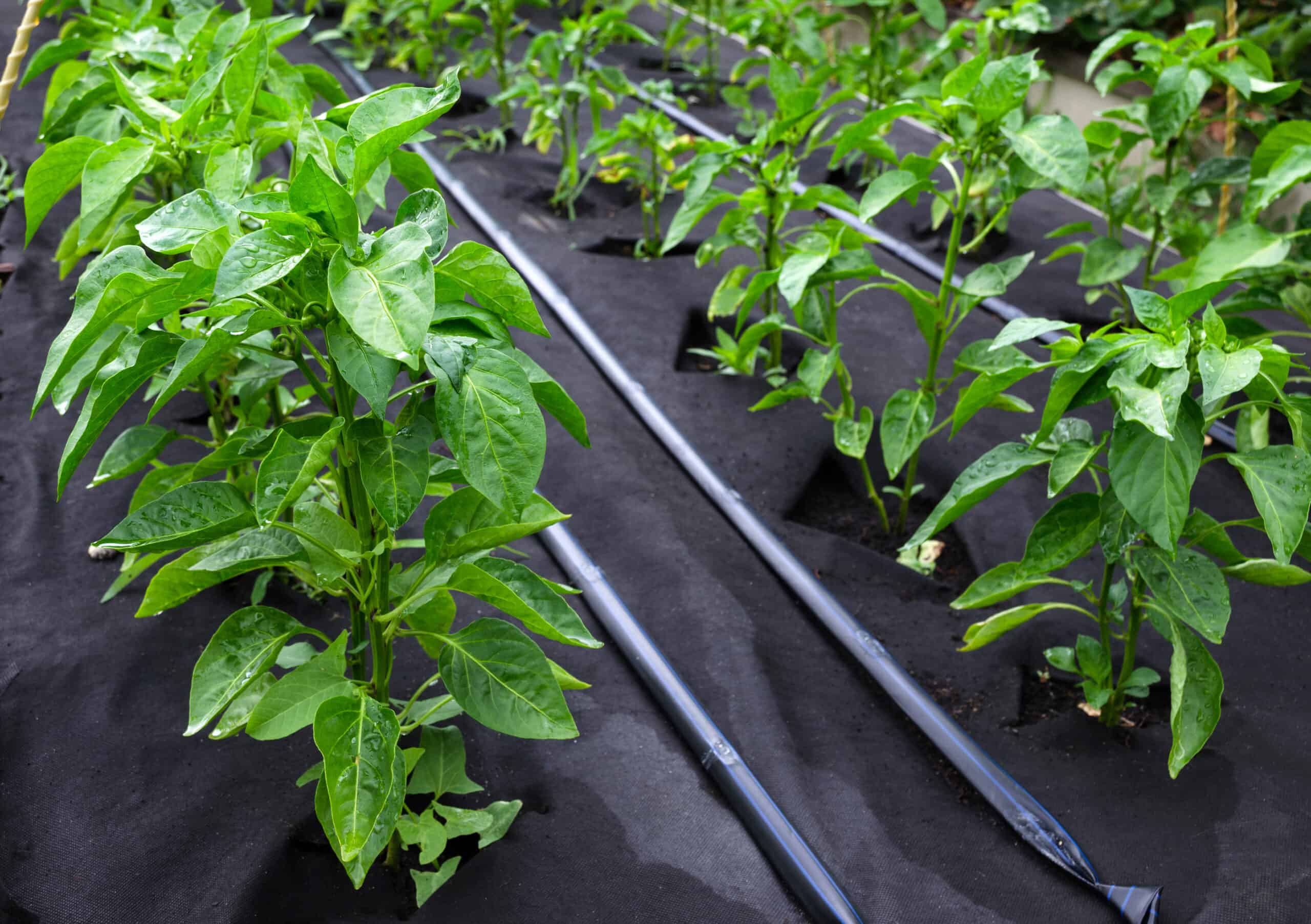
Caring for peppers
Early in the season protect young plants from cold and pest insects by covering the growing bed with a floating row cover. When the peppers begin to blossom, remove the cover so that bees and other insects can pollinate the plants. (You can also cover young plants with cloches or plastic milk jugs.)
Once soil and nighttime temperatures have warmed and summer heat comes, mulch around pepper plants with a finely-shredded organic mulch such as a mixture of grass clippings and straw. Mulch will retain soil moisture and keep the humidity high around plants (remember, peppers are tropical plants and love humidity). Place the mulch at least an inch or two from the stem and as much as 6 inches deep out to the drip line.
Stake or cage peppers heavy with fruit (it’s easier to set the cage or stake at planting time). Peppers have brittle stems and branches. Use elastic plastic tape to tie plants to stakes.
Temperatures greater than 90°F can cause buds and blossoms to drop, particularly when the air is dry. Where summers are very hot put shade-cloth frames in place to protect peppers or plant on the north side of taller plants such as tomatoes or corn that can offer shade.
Early in the season pick the first blossoms or set of fruits to encourage the plant to keep bearing and grow larger fruits later in the season.
- Keep planting beds well-weeded to avoid competition.
- Peppers are shallow-rooted, so cultivate around peppers with care.
- Mulch around peppers with aged compost or straw to keep soil temperature and moisture even.
- Plastic mulch can improve pepper yields. Organic compost mulches will reduce weeding and watering, but not fruit yields.
- Avoid high nitrogen fertilizers which will create large leafy plants with few or no fruits.
- Feed plants compost tea or water with a dilute fish emulsion solution every 10 days.
- Support pepper plants with a stake or cage; plants heavy with fruit can break or topple. Pepper branches are brittle and can easily break.
- High temperatures and wind can cause flowers to drop and plants not to set fruit.
Mulching peppers
Mulching peppers with straw or grass clippings around plants. A thick mulch will stop weeds from growing and keep moisture in the soil when the weather gets hot. Use hay, straw, leaves, or grass clippings to mulch peppers. Organic mulches decompose and feed the soil and earthworms below. Make sure that the mulch you put down does not contain flowers or seeds; no sense in encouraging weed growth this season or next. If you put down a black plastic mulch to warm the soil early on, you can lift that once the soil has warmed and use the organic mulch in its place.
Weeding peppers
Keep weeds away from peppers. Weeds compete with peppers and other crops for the same space, water, and nutrients. Regular weeding will keep weeds from getting a foothold in the garden. Avoid damaging roots by gently hand-pulling weeds. Most young weed roots will not reach more than an inch deep into the soil. Avoid deep cultivation which can harm crop roots.
More tips: Pepper Planting: Easy Steps to a Bumper Crop.
Good Products for Growing Peppers:
- Espoma Garden Tone 3-4-4 Fertilizer
- Epsom Salt Plus Plant Nutrients Magriculture
- Tomato Grower’s Answer Book
- Neem Bliss 100-% Cold Pressed Neem Oil
- Safer Brand Insect Killing Soap
- Monterey BT Caterpillar Killer
- Southern Ag Liquid Copper Fungicide
- Harris Diatomaceous Earth with Duster
- Natures Good Guys Beneficial Nematodes
Pepper pests and diseases
Peppers can be attacked by aphids, pepper maggots, pepper weevils, tomato hornworms, Colorado potato beetles, leaf miners, flea beetles, and corn borers. Control these pest insects with insecticides like Bt for the caterpillars and pyrethrum for the others. Hot pepper spray will also repel these pests: combine a handful of hot peppers, several cloves of garlic, a tablespoon of non-detergent soap, and three cups of lukewarm water to make the spray.
Pepper pests
- Peppers can be attacked by aphids, cutworms, flea beetles, and hornworms.
- Discourage cutworms by placing a collar around each transplant at the time of planting.
- Handpick hornworms off of plants. Drop them into a can of soapy water.
- Flea beetles and aphids can be partially controlled by hosing them off the plants and pinching out infested foliage.
Pepper diseases
Keep the garden weed-free to slow down diseases and pest insect populations. Weeds can also spread fungi and viruses that harbor insect diseases.
- Peppers are susceptible to rot, blossom end rot, anthracnose, tobacco mosaic virus, bacterial spot, and mildew.
- Plant disease-resistant varieties. Seed packets and plant labels will note disease resistance.
- Keep the garden clean and free of weeds where pests and diseases can shelter.
- Remove infected plants before a disease can spread.
- If you smoke, wash your hands before working with the plants to avoid spreading the tobacco mosaic virus.
More to pepper pests and diseases: Pepper Growing Problems: Troubleshooting.
Propagating peppers
- Start pepper seed indoors 7 to 10 weeks before the date you intend to set seedlings into the garden.
- Sow 3 to 4 seeds in a pot or across flats.
- Sow seed ¼ to ½ inch (7-13 mm) deep.
- Germination soil temperature is 75-95°F (24-35°C); the optimum soil temperature for germinating seed is 85°F (29°C).
- Germination takes 7 to 10 days at 85°F (29°C) or warmer.
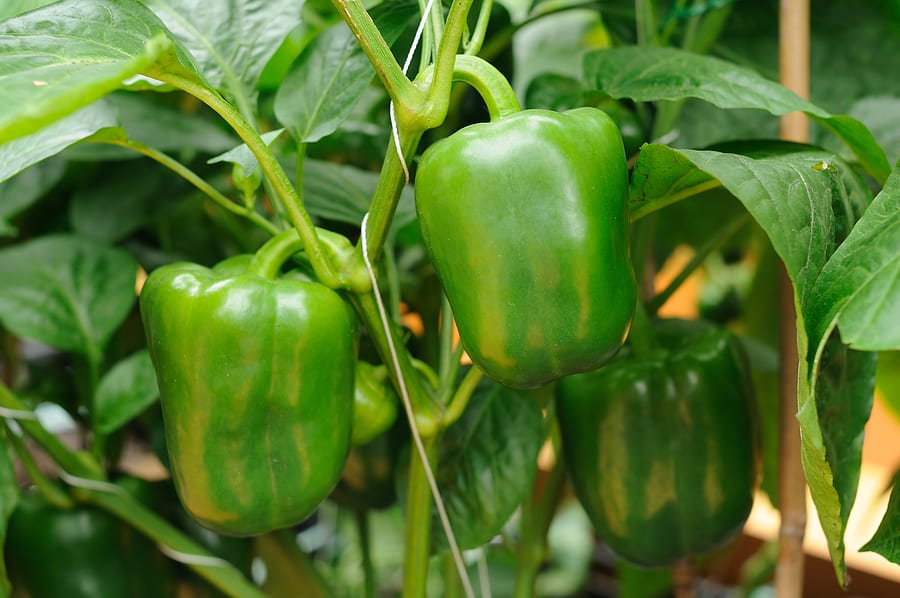
Harvesting peppers
Sweet bell peppers mature in 60 to 70 days. Sweet peppers can be harvested and used before they mature, or they can be left on the plant until they reach full size and ripen to a deep red color. Hot peppers are ready any time they are usable size.
Sweet peppers, like cucumbers, can be harvested when immature, but allowing the pepper to ripen on the vine improves quality. The flavor does not truly develop until maturity. However, if you pick peppers throughout the season, the plants will continue to produce. Tip: leave some peppers on each plant to ripen and harvest; pick others throughout the season when they reach table size.
Most sweet and hot peppers require about 70 days from transplanting until the first fruits are ready. From the start of harvest, peppers can take another 3 to 4 weeks to reach full maturity–that is to turn their mature color–usually red, but sometimes yellow or orange. Keep in mind that the cooler your growing season, the more time must be added for peppers to mature.
Cut peppers off the plant, don’t pull them. Use a sharp knife, scissors, or shears to cut peppers away from the stem. Pulling peppers away from the plant can result in broken stems and even uprooted plants. Leave about an inch of the stem with the pepper at harvest.
Peppers will continue to ripen for a few days if left on the kitchen counter.
Harvesting sweet bell peppers
- Peppers are ready for harvest in 60 to 95 days after sowing
- Peppers mature from green to red as the seeds inside mature.
- Fruit color change can be slow when the weather is not consistently warm.
- Sweet peppers become sweeter as they ripen and turn color.
- Cut peppers off the vine with a garden shear or scissors; don’t pull them.
- Leave a short amount of stem attached to the pepper at harvest time.
- Peppers will continue to change color and ripen after harvest if placed in a warm spot out of direct sunlight.
Harvesting hot chili peppers
See How to Plant, Grow, and Harvest Hot Peppers.
More harvest tips: How to Harvest and Store Peppers.
Storing and preserving peppers
Don’t store peppers in plastic bags or wrap or in the vegetable crisper of the refrigerator. Try your best to use them the day you harvest them.
- Peppers can be stored in a cool, moist place for 2 to 3 weeks.
- Peppers can be refrigerated for up to 10 days; place them in a plastic bag to avoid cold burn.
- Blanched peppers can be stored in the freezer for 4 to 6 months.
- Peppers can be dried or pickled whole or in pieces.
- Be careful when handling hot peppers. They contain a compound called capsaicin which is concentrated in the veins, ribs, and seeds. Capsaicin can burn your eyes, nose, or mouth. Washed your hands thoroughly after handling hot
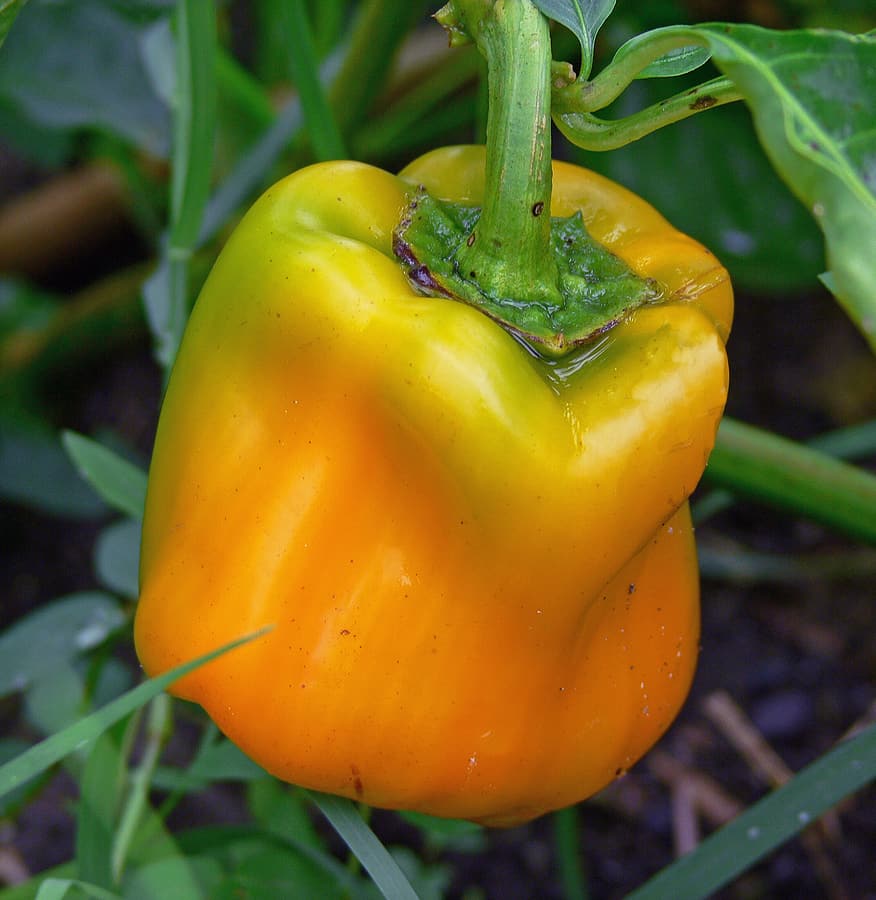
Sweet bell pepper varieties to grow
Sweet peppers vary in shape and color and include the slender banana pepper; the short, round cherry pepper; the small bright-red, heart-shaped pimiento; the multi-colored Italian frying pepper; and the blocky green to yellow to orange to red bell pepper. Sweet peppers can be eaten raw, cooked, or pickled. Not all sweet pepper varieties are mildly flavored; some can be spicy and hot.
- Blocky Sweet Peppers: ‘Ace’ (55 days); ‘Bell Boy’ (75 days); ‘Bell Captain’ (72 days); ‘Big Bertha’ (72 days); ‘Bull Nose’ (55-70 days); ‘California Wonder’ (73 days); ‘Camelot’ (74 days); ‘Elisa’ (72 days); ‘Emerald Giant’ (74 days); ‘Jupiter Elite’ (66 days); ‘King Arthur’ (72 days);’ Little Dipper’ (66 days); ‘Midway’ (70 days); ‘North Star’ (66 days); ‘Secret’ (60 days); ‘Yankee Bell’ (60 days); ‘Yolo Wonder’ (73 days).
- Red Sweet Bells: ‘Cardinal’ (70 days); ‘Rampage’ (66 days); ‘Redwing’ (72 days); ‘Summer Sweet’ (76 days).
- Long Sweet Peppers: ‘Banana Supreme’ (65 days); ‘Hungarian Yellow Wax’ (65 days).
- Space Savers: ‘Baby Bell’ (55 days); ‘Jingle Bells’ (55 days); ‘Park’s Pot’ (45 days).
- Yellow-Orange Sweet Bells: ‘Canary’ (72 days); ‘Gold Finch’ (72 days); ‘Klondike Bell’ (72 days); Orobelle (70 days); ‘Peppourri Orange’ (75 days); ‘Summer Sweet’ (86 days).
- Heart-Shaped Sweet Peppers: ‘Pimento’ (65-80 days).
- Other Sweet Peppers: ‘Blue Jay’ (73 days); ‘Chocolate Beauty’ (58-86 days); ‘Cubanelle’ (62 days); ‘Purple Beauty’ (70 days).
Peppers to plant: Pepper Varieties: Best Bets and Easy-To-Grow.
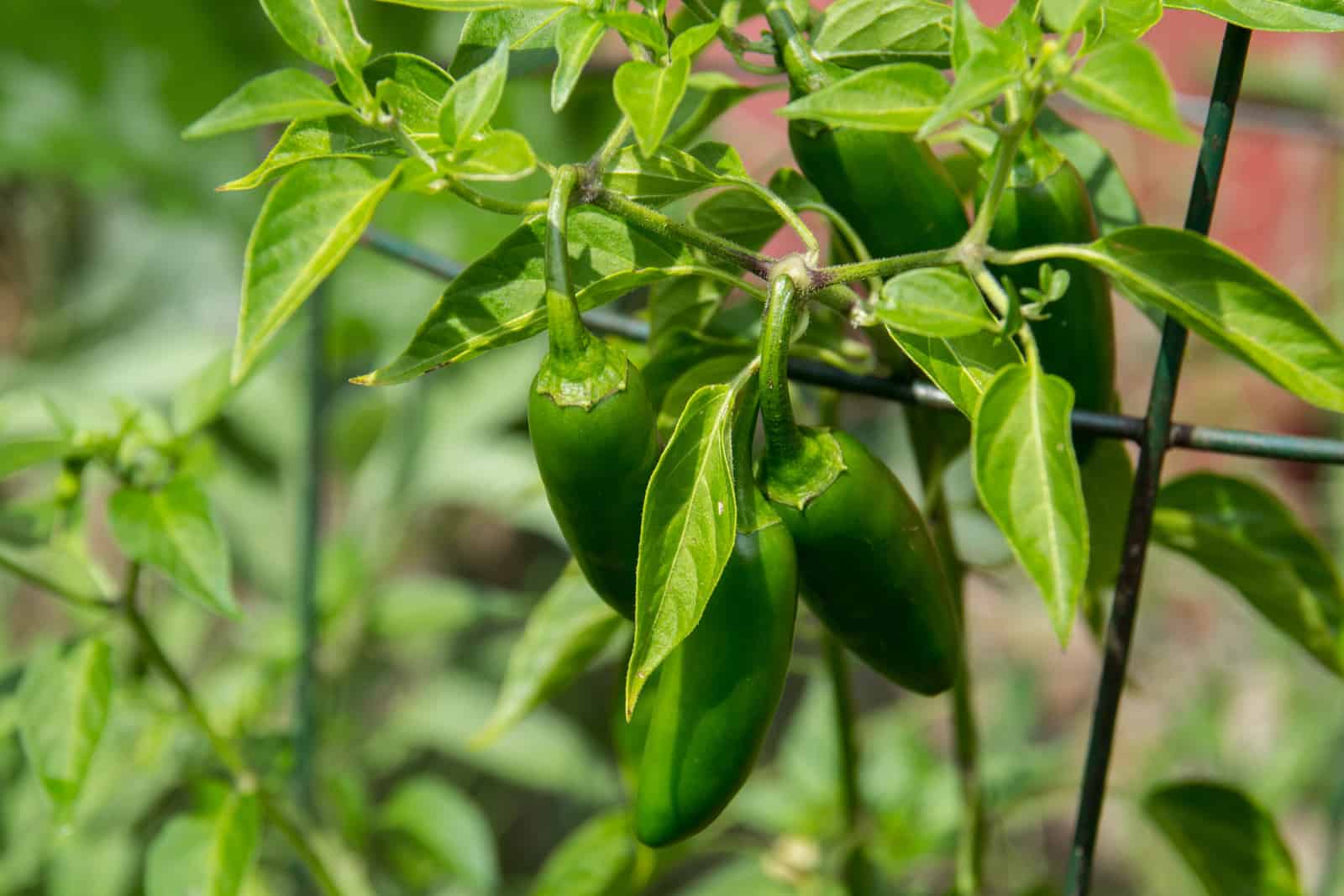
Hot chili pepper varieties to grow
Hot peppers–also called chili peppers–vary in shape and color and include the bell-shaped pepper, the heart-shaped pimiento, the short and long podded yellow wax, the conical-shaped jalapeño, and the cayenne. Peppers easily cross-pollinate there are thousands of different hot peppers.
Hot peppers are rated by their heat–called Scoville heat units (SHU). The greater the number of units on the Scoville scale the hotter the pepper. Here are several hot pepper varieties starting with the hottest (all of these will cause most people discomfort when eaten):
- ‘Bhut Jolokia’ (also called ‘Ghost Pepper’): 1,001,304 SHU (100days)
- ‘Scotch Bonnet’: 100,000-580,000 SHU (120 days)
- ‘Habanero’: 100,000-500,000 SHU (90-100 days)
- ‘Jamaican Hot’: 100,000-200,000 SHU (95 days)
- ‘Chiltepin’: 100,000 SHU (95 days)
- ‘Thai’: 50,000-100,000 SHU (90 days)
- ‘Cayenne’: 30,000-50,000 SHU (72 days)
- ‘Aji’: 30,000-50,000 SHU (85-90 days)
- ‘Tabasco’: 30,000-50,000 SHU (80 days)
- ‘Serrano’: 8,000-23,000 SHU (75-80 days)
- ‘Mirasol’: 5,000 SHU (100 days)
- ‘Jalapeño’: 2,500-9,000 SHU (75 days)
More on hot peppers: How to Choose a Chili Pepper.
About peppers
- Peppers are tender perennials that are grown as annuals.
- Peppers grow on compact erect bushes 1½ to 2 feet tall.
- The fruit follows a single flower growing at the angle between a leaf and a stem.
- Botanical name: Capsicum annuum (sweet and hot peppers).
- Origin: New World Tropics.
Pepper articles at Harvest to Table:
How to Grow Sweet Bell Peppers
How to Plant and Grow Hot Chili Peppers
Six Tips to Grow Peppers for Flavor
7 Tips for Growing Peppers in Pots
How to Harvest and Store Peppers
Five Ways to Cook and Serve Sweet Peppers
Five Ways to Cook and Serve Chili Peppers
Beginner’s Guide to Canning Peppers
Pepper Growing Problems Troubleshooting
Mid-Season Pepper Problem Cures
Epsom Salt, Milk, and Organic Fertilizers for Tomatoes and Peppers
How to Prevent Blossom Drop — Tomatoes and Peppers
Garden Planning Books at Amazon:
- Tomato Grower’s Answer Book
- Vegetable Garden Almanac & Planner
- Kitchen Garden Grower’s Guide Vegetable Encyclopedia
- Vegetable Garden Grower’s Guide
More how to grow articles:
Learn how to plant, grow, and harvest your favorite vegetables. Click below for all you need to know.
- Artichoke
- Arugula
- Asparagus
- Beans, Snap
- Beets
- Broad Beans
- Broccoli
- Brussels Sprouts
- Cabbage
- Cantaloupe — Melons
- Cardoon
- Carrots
- Cauliflower
- Celeriac
- Celery
- Chard
- Chayote Squash
- Chickpeas
- Chicory
- Chinese Cabbage
- Collards
- Corn Salad
- Corn, Sweet
- Cresses
- Cucumbers
- Eggplant
- Endive and Escarole
- Fava Beans
- Florence Fennel
- Garbanzo Beans
- Garlic
- Horseradish
- Jerusalem Artichoke
- Kale
- Kohlrabi
- Leeks
- Lettuce
- Lima Beans
- Melons
- Mizuna
- Mustard Greens
- New Zealand Spinach
- Okra
- Onions
- Parsnips
- Peanuts
- Peas
- Peppers
- Potatoes
- Pumpkins
- Radicchio
- Radishes
- Rhubarb
- Rutabaga
- Salsify
- Shallots
- Sorrel
- Southern Peas
- Soybeans
- Spinach
- Squash, Summer
- Squash, Winter
- Sunchokes
- Sweet Potato
- Swiss Chard
- Taro
- Tomatillo
- Tomatoes
- Turnips
- Watermelon
- Zucchini



